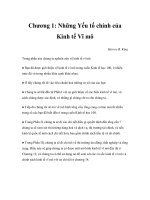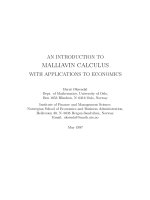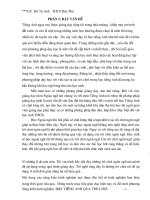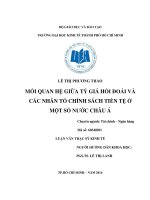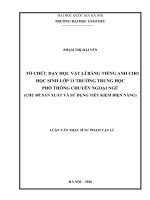Introductiont to malliavin calculus with application to economics
Bạn đang xem bản rút gọn của tài liệu. Xem và tải ngay bản đầy đủ của tài liệu tại đây (673.06 KB, 83 trang )
AN INTRODUCTION TO
MALLIAVIN CALCULUS
WITH APPLICATIONS TO ECONOMICS
Bernt Øksendal
Dept. of Mathematics, University of Oslo,
Box 1053 Blindern, N–0316 Oslo, Norway
Institute of Finance and Management Science,
Norwegian School of Economics and Business Administration,
Helleveien 30, N–5035 Bergen-Sandviken, Norway.
Email:
May 1997
Preface
These are unpolished lecture notes from the course BF 05 “Malliavin calculus with appli-
cations to economics”, which I gave at the Norwegian School of Economics and Business
Administration (NHH), Bergen, in the Spring semester 1996. The application I had in
mind was mainly the use of the Clark-Ocone formula and its generalization to finance,
especially portfolio analysis, option pricing and hedging. This and other applications are
described in the impressive paper by Karatzas and Ocone [KO] (see reference list in the
end of Chapter 5). To be able to understand these applications, we had to work through
the theory and methods of the underlying mathematical machinery, usually called the
Malliavin calculus. The main literature we used for this part of the course are the books
by Ustunel [U] and Nualart [N] regarding the analysis on the Wiener space, and the
forthcoming book by Holden, Øksendal, Ubøe and Zhang [HØUZ] regarding the related
white noise analysis (Chapter 3). The prerequisites for the course are some basic knowl-
edge of stochastic analysis, including Ito integrals, the Ito representation theorem and the
Girsanov theorem, which can be found in e.g. [Ø1].
The course was followed by an inspiring group of (about a dozen) students and employees
at HNN. I am indebted to them all for their active participation and useful comments. In
particular, I would like to thank Knut Aase for his help in getting the course started and
his constant encouragement. I am also grateful to Kerry Back, Darrell Duffie, Yaozhong
Hu, Monique Jeanblanc-Picque and Dan Ocone for their useful comments and to Dina
Haraldsson for her proficient typing.
Oslo, May 1997
Bernt Øksendal
i
Contents
1 The Wiener-Ito chaos expansion 1.1
Exercises 1.8
2 The Skorohod integral 2.1
The Skorohod integral is an extension of the Ito integral 2.4
Exercises 2.6
3 White noise, the Wick product and stochastic integration 3.1
The Wiener-Itˆo chaos expansion revisited 3.3
Singular (pointwise) white noise 3.6
The Wick product in terms of iterated Ito integrals 3.9
Some properties of the Wick product 3.9
Exercises 3.12
4 Differentiation 4.1
Closability of the derivative operator 4.7
Integration by parts 4.8
Differentiation in terms of the chaos expansion 4.11
Exercises 4.13
5 The Clark-Ocone formula and its generalization. Application to finance . . 5.1
The Clark-Ocone formula 5.5
The generalized Clark-Ocone formula 5.5
Application to finance 5.10
The Black-Scholes option pricing formula and generalizations 5.13
Exercises 5.15
ii
6 Solutions to the exercises 6.1
iii
1 The Wiener-Ito chaos expansion
The celebrated Wiener-Ito chaos expansion is fundamental in stochastic analysis. In
particular, it plays a crucial role in the Malliavin calculus. We therefore give a detailed
proof.
The first version of this theorem was proved by Wiener in 1938. Later Ito (1951) showed
that in the Wiener space setting the expansion could be expressed in terms of iterated Ito
integrals (see below).
Before we state the theorem we introduce some useful notation and give some auxiliary
results.
Let W (t)=W (t, ω); t ≥ 0, ω ∈ Ω be a 1-dimensional Wiener process (Brownian motion)
on the probability space (Ω, F,P) such that W (0,ω) = 0 a.s. P .
For t ≥ 0 let F
t
be the σ-algebra generated by W (s, ·); 0 ≤ s ≤ t. Fix T>0 (constant).
A real function g :[0,T]
n
→ R is called symmetric if
(1.1) g(x
σ
1
, ,x
σ
n
)=g(x
1
, ,x
n
)
for all permutations σ of (1, 2, ,n). If in addition
(1.2) g
2
L
2
([0,T ]
n
)
:=
[0,T ]
n
g
2
(x
1
, ,x
n
)dx
1
···dx
n
< ∞
we say that g ∈
L
2
([0,T]
n
), the space of symmetric square integrable functions on [0,T]
n
.
Let
(1.3) S
n
= {(x
1
, ,x
n
) ∈ [0,T]
n
;0≤ x
1
≤ x
2
≤···≤x
n
≤ T }.
The set S
n
occupies the fraction
1
n!
of the whole n-dimensional box [0,T]
n
. Therefore, if
g ∈
L
2
([0,T]
n
) then
(1.4) g
2
L
2
([0,T ]
n
)
= n!
S
n
g
2
(x
1
, ,x
n
)dx
1
dx
n
= n!g
2
L
2
(S
n
)
If f is any real function defined on [0,T]
n
, then the symmetrization
˜
f of f is defined by
(1.5)
f(x
1
, ,x
n
)=
1
n!
σ
f(x
σ
1
, ,x
σ
n
)
where the sum is taken over all permutations σ of (1, ,n). Note that
f = f if and only
if f is symmetric. For example if
f(x
1
,x
2
)=x
2
1
+ x
2
sin x
1
then
f(x
1
,x
2
)=
1
2
[x
2
1
+ x
2
2
+ x
2
sin x
1
+ x
1
sin x
2
].
1.1
Note that if f is a deterministic function defined on S
n
(n ≥ 1) such that
f
2
L
2
(S
n
)
:=
S
n
f
2
(t
1
, ,t
n
)dt
1
···dt
n
< ∞,
then we can form the (n-fold) iterated Ito integral
(1.6) J
n
(f): =
T
0
t
n
0
···
t
3
0
(
t
2
0
f(t
1
, ,t
n
)dW (t
1
))dW (t
2
) ···dW (t
n−1
)dW (t
n
),
because at each Ito integration with respect to dW (t
i
) the integrand is F
t
-adapted and
square integrable with respect to dP ×dt
i
,1≤ i ≤ n.
Moreover, applying the Ito isometry iteratively we get
E[J
2
n
(h)] = E[{
T
0
(
t
n
0
···
t
2
0
h(t
1
, ,t
n
)dW (t
1
) ···)dW (t
n
)}
2
]
=
T
0
E[(
t
n
0
···
t
2
0
h(t
1
, ,t
n
)dW (t
1
) ···dW (t
n−1
))
2
]dt
n
= ···=
T
0
t
n
0
···
t
2
0
h
2
(t
1
, ,t
n
)dt
1
···dt
n
= h
2
L
2
(S
n
)
.(1.7)
Similarly, if g ∈ L
2
(S
m
) and h ∈ L
2
(S
n
) with m<n, then by the Ito isometry applied
iteratively we see that
E[J
m
(g)J
n
(h)]
= E[{
T
0
(
s
m
0
···
s
2
0
g(s
1
, ,s
m
)dW (s
1
) ···dW (s
m
)}
{
T
0
(
s
m
0
···
t
2
0
h(t
1
, ,t
n−m
,s
1
, ,s
m
)dW (t
1
) ···)dW (s
m
)}]
=
T
0
E[{
s
m
0
···
s
2
0
g(s
1
, ,s
m−1
,s
m
)dW (s
1
) ···dW (s
m−1
)}
{
s
m
0
···
t
2
0
h(t
1
, ,s
m−1
,s
m
)dW (t
1
) ···dW (s
m−1
)}]ds
m
=
T
0
s
m
0
···
s
2
0
E[g(s
1
,s
2
, ,s
m
)
s
1
0
···
t
2
0
h(t
1
, ,t
n−m
,s
1
, ,s
m
)
dW (t
1
) ···dW (t
n−m
)]ds
1
, ···ds
m
=0(1.8)
because the expected value of an Ito integral is zero.
1.2
We summarize these results as follows:
(1.9) E[J
m
(g)J
n
(h)] =
0ifn = m
(g, h)
L
2
(S
n
)
if n = m
where
(1.10) (g, h)
L
2
(S
n
)
=
S
n
g(x
1
, ,x
n
)h(x
1
, ,x
n
)dx
1
···dx
n
is the inner product of L
2
(S
n
).
Note that (1.9) also holds for n =0orm = 0 if we define
J
0
(g)=g if g is a constant
and
(g, h)
L
2
(S
0
)
= gh if g,h are constants.
If g ∈
L
2
([0,T]
n
) we define
(1.11) I
n
(g): =
[0,T ]
n
g(t
1
, ,t
n
)dW
⊗n
(t): = n!J
n
(g)
Note that from (1.7) and (1.11) we have
(1.12) E[I
2
n
(g)] = E[(n!)
2
J
2
n
(g)]=(n!)
2
g
2
L
2
(S
n
)
= n!g
2
L
2
([0,T ]
n
)
for all g ∈
L
2
([0,T]
n
).
Recall that the Hermite polynomials h
n
(x); n =0, 1, 2, are defined by
(1.13) h
n
(x)=(−1)
n
e
1
2
x
2
d
n
dx
n
(e
−
1
2
x
2
); n =0, 1, 2,
Thus the first Hermite polynomials are
h
0
(x)=1,h
1
(x)=x, h
2
(x)=x
2
− 1,h
3
(x)=x
3
− 3x,
h
4
(x)=x
4
− 6x
2
+3,h
5
(x)=x
5
− 10x
3
+15x,
There is a useful formula due to Ito [I] for the iterated Ito integral in the special case
when the integrand is the tensor power of a function g ∈ L
2
([0,T]):
(1.14) n!
T
0
t
n
0
···
t
2
0
g(t
1
)g(t
2
) ···g(t
n
)dW (t
1
) ···dW (t
n
)=g
n
h
n
(
θ
g
),
where
g = g
L
2
([0,T ])
and θ =
T
0
g(t)dW (t).
1.3
For example, choosing g ≡ 1 and n = 3 we get
6 ·
T
0
t
3
0
t
2
0
dW (t
1
)dW (t
2
)dW (t
3
)=T
3/2
h
3
(
W (T )
T
1/2
)=W
3
(T ) −3TW(T ).
THEOREM 1.1. (The Wiener-Ito chaos expansion) Let ϕ be an F
T
-measurable
random variable such that
ϕ
2
L
2
(Ω)
:=ϕ
2
L
2
(P )
:=E
P
[ϕ
2
] < ∞.
Then there exists a (unique) sequence {f
n
}
∞
n=0
of (deterministic) functions f
n
∈
L
2
([0,T]
n
)
such that
(1.15) ϕ(ω)=
∞
n=0
I
n
(f
n
) (convergence in L
2
(P )).
Moreover, we have the isometry
(1.16) ϕ
2
L
2
(P )
=
∞
n=0
n!f
n
2
L
2
([0,T ]
n
)
Proof. By the Ito representation theorem there exists an F
t
-adapted process ϕ
1
(s
1
,ω),
0 ≤ s
1
≤ T such that
(1.17) E[
T
0
ϕ
2
1
(s
1
,ω)ds
1
] ≤ϕ
2
L
2
(P )
and
(1.18) ϕ(ω)=E[ϕ]+
T
0
ϕ
1
(s
1
,ω)dW (s
1
)
Define
(1.19) g
0
= E[ϕ] (constant).
For a.a. s
1
≤ T we apply the Ito representation theorem to ϕ
1
(s
1
,ω) to conclude that
there exists an F
t
-adapted process ϕ
2
(s
2
,s
1
,ω); 0 ≤ s
2
≤ s
1
such that
(1.20) E[
s
1
0
ϕ
2
2
(s
2
,s
1
,ω)ds
2
] ≤ E[ϕ
2
1
(s
1
)] < ∞
and
(1.21) ϕ
1
(s
1
,ω)=E[ϕ
1
(s
1
)] +
s
1
0
ϕ
2
(s
2
,s
1
,ω)dW (s
2
).
1.4
Substituting (1.21) in (1.18) we get
(1.22) ϕ(ω)=g
0
+
T
0
g
1
(s
1
)dW (s
1
)+
T
0
(
s
1
0
ϕ
2
(s
2
,s
1
,ω)dW (s
2
)dW (s
1
)
where
(1.23) g
1
(s
1
)=E[ϕ
1
(s
1
)].
Note that by the Ito isometry, (1.17) and (1.20) we have
(1.24) E[{
T
0
(
s
1
0
ϕ
2
(s
1
,s
2
,ω)dW (s
2
))dW (s
1
)}
2
]=
T
0
(
s
1
0
E[ϕ
2
2
(s
1
,s
2
,ω)]ds
2
)ds
1
≤ϕ
2
L
2
(P )
.
Similarly, for a.a. s
2
≤ s
1
≤ T we apply the Ito representation theorem to ϕ
2
(s
2
,s
1
,ω)to
get an F
t
-adapted process ϕ
3
(s
3
,s
2
,s
1
,ω); 0 ≤ s
3
≤ s
2
such that
(1.25) E[
s
2
0
ϕ
2
3
(s
3
,s
2
,s
1
,ω)ds
3
] ≤ E[ϕ
2
2
(s
2
,s
1
)] < ∞
and
(1.26) ϕ
2
(s
2
,s
1
,ω)=E[ϕ
2
(s
2
,s
1
,ω)] +
s
2
0
ϕ
3
(s
3
,s
2
,s
1
,ω)dW (s
3
).
Substituting (1.26) in (1.22) we get
ϕ(ω)=g
0
+
T
0
g
1
(s
1
)dW (s
1
)+
T
0
(
s
1
0
g
2
(s
2
,s
1
)dW (s
2
))dW (s
1
)
+
T
0
(
s
1
0
(
s
2
0
ϕ
3
(s
3
,s
2
,s
1
,ω)dW (s
3
))dW (s
2
))dW (s
1
),(1.27)
where
(1.28) g
2
(s
2
,s
1
)=E[ϕ
2
(s
2
,s
1
)]; 0 ≤ s
2
≤ s
1
≤ T.
By the Ito isometry, (1.17), (1.20) and (1.25) we have
(1.29) E[{
T
0
s
1
0
s
2
0
ϕ
3
(s
3
,s
2
,s
1
,ω)dW (s
3
)dW (s
2
)dW (s
3
)}
2
] ≤ϕ
2
L
2
(P )
.
By iterating this procedure we obtain by induction after n steps a process ϕ
n+1
(t
1
,t
2
, ,
t
n+1
,ω); 0 ≤ t
1
≤ t
2
≤ ···≤ t
n+1
≤ T and n + 1 deterministic functions g
0
,g
1
, ,g
n
with g
0
constant and g
k
defined on S
k
for 1 ≤ k ≤ n, such that
(1.30) ϕ(ω)=
n
k=0
J
k
(g
k
)+
S
n+1
ϕ
n+1
dW
⊗(n+1)
,
1.5
where
(1.31)
S
n+1
ϕ
n+1
dW
⊗(n+1)
=
T
0
t
n+1
0
···
t
2
0
ϕ
n+1
(t
1
, ,t
n+1
,ω)dW (t
1
) ···dW (t
n+1
)
is the (n + 1)-fold iterated integral of ϕ
n+1
. Moreover,
(1.32) E[{
S
n+1
ϕ
n+1
dW
⊗(n+1)
}
2
] ≤ϕ
2
L
2
(Ω)
.
In particular, the family
ψ
n+1
:=
S
n+1
ϕ
n+1
dW
⊗(n+1)
; n =1, 2,
is bounded in L
2
(P ). Moreover
(1.33) (ψ
n+1
,J
k
(f
k
))
L
2
(Ω)
= 0 for k ≤ n, f
k
∈ L
2
([0,T]
k
).
Hence by the Pythagorean theorem
(1.34) ϕ
2
L
2
(Ω)
=
n
k=0
J
k
(g
k
)
2
L
2
(Ω)
+ ψ
n+1
2
L
2
(Ω)
In particular,
n
k=0
J
k
(g
k
)
2
L
2
(Ω)
< ∞
and therefore
∞
k=0
J
k
(g
k
) is strongly convergent in L
2
(Ω). Hence
lim
n→∞
ψ
n+1
=: ψ exists (limit in L
2
(Ω))
But by (1.33) we have
(1.35) (J
k
(f
k
),ψ)
L
2
(Ω)
= 0 for all k and all f
k
∈ L
2
([0,T]
k
)
In particular, by (1.14) this implies that
E[h
k
(
θ
g
) ·ψ] = 0 for all g ∈ L
2
([0,T]), all k ≥ 0
where θ =
T
0
g(t)dW (t).
But then, from the definition of the Hermite polynomials,
E[θ
k
· ψ] = 0 for all k ≥ 0
1.6
which again implies that
E[exp θ · ψ]=
∞
k=0
1
k!
E[θ
k
· ψ]=0.
Since the family
{exp θ; g ∈ L
2
([0,T])}
is dense in L
2
(Ω) (see [Ø1], Lemma 4.9), we conclude that
ψ =0.
Hence
(1.36) ϕ(ω)=
∞
k=0
J
k
(g
k
) (convergence in L
2
(Ω))
and
(1.37) ϕ
2
L
2
(Ω)
=
n
k=0
J
k
(g
k
)
2
L
2
(Ω)
.
Finally, to obtain (1.15)–(1.16) we proceed as follows:
The function g
n
is only defined on S
n
, but we can extend g
n
to [0,T]
n
by putting
(1.38) g
n
(t
1
, ,t
n
)=0 if(t
1
, ,t
n
) ∈ [0,T]
n
\ S
n
.
Now define
f
n
=
g
n
, the symmetrization of g.
Then
I
n
(f
n
)=n!J
n
(f
n
)=n!J
n
(
g
n
)=J
n
(g
n
)
and (1.15)–(1.16) follow from (1.36) and (1.37).
Examples
1) What is the Wiener-Ito expansion of
ϕ(ω)=W
2
(T,ω)?
From (1.14) we get
2
T
0
(
t
2
0
dW (t
1
))dW (t
2
)=Th
2
(
W (T )
T
1/2
)=W
2
(T ) −T,
and therefore
W
2
(T )=T + I
2
(1).
1.7
2) Note that for t ∈ (0,T)wehave
T
0
(
t
2
0
X
{t
1
<t<t
2
}
(t
1
,t
2
)dW (t
1
))dW (t
2
)
=
T
t
W (t)dW (t
2
)=W (t)(W (T ) − W(t)).
Hence, if we put
ϕ(ω)=W (t)(W (T ) − W (t)),g(t
1
,t
2
)=X
{t
1
<t<t
2
}
we see that
ϕ(ω)=J
2
(g)=2J
2
(
g)=I
2
(f
2
),
where
f
2
(t
1
,t
2
)=
g(t
1
,t
2
)=
1
2
(X
{t
1
<t<t
2
}
+ X
{t
2
<t<t
1
}
).
Exercises
1.1 a) Let h
n
(x); n =0, 1, 2, be the Hermite polynomials, defined in (1.13). Prove
that
exp(tx −
t
2
2
)=
∞
n=0
t
n
n!
h
n
(x) for all t, x.
(Hint: Write
exp(tx −
t
2
2
) = exp(
1
2
x
2
) ·exp(−
1
2
(x −t)
2
)
and apply the Taylor formula on the last factor.)
b) Show that if λ>0 then
exp(tx −
t
2
λ
2
)=
∞
n=0
t
n
λ
n
2
n!
h
n
(
x
√
λ
).
c) Let g ∈ L
2
([0,T]) be deterministic. Put
θ = θ(ω)=
T
0
g(s)dW (s)
and
g = g
L
2
([0,T ])
=(
T
0
g
2
(s)ds)
1/2
.
Show that
exp(
T
0
g(s)dW (s) −
1
2
g
2
)=
∞
n=0
g
n
n!
h
n
(
θ
g
)
1.8
d) Let t ∈ [0,T]. Show that
exp(W (t) −
1
2
t)=
∞
n=0
t
n/2
n!
h
n
(
W (t)
√
t
).
1.2 Find the Wiener-Ito chaos expansion of the following random variables:
a) ϕ(ω)=W (t, ω)(t ∈ [0,T] fixed)
b) ϕ(ω)=
T
0
g(s)dW (s)(g ∈ L
2
([0,T]) deterministic)
c) ϕ(ω)=W
2
(t, ω)(t ∈ [0,T] fixed)
d) ϕ(ω) = exp(
T
0
g(s)dW (s)) (g ∈ L
2
([0,T]) deterministic)
(Hint: Use (1.14).)
1.3 The Ito representation theorem states that if F ∈ L
2
(Ω) is F
T
-measurable, then
there exists a unique F
t
-adapted process ϕ(t, ω) such that
(1.40) F (ω)=E[F ]+
T
0
ϕ(t, ω)dW (t).
(See e.g. [Ø1], Theorem 4.10.)
As we will show in Chapter 5, this result is important in mathematical finance. Moreover,
it is important to be able to find more explicitly the integrand ϕ(t, ω). This is achieved
by the Clark-Ocone formula, which says that (under some extra conditions)
(1.41) ϕ(t, ω)=E[D
t
F |F
t
](ω),
where D
t
F is the (Malliavin) derivative of F . We will return to this in Chapters 4 and 5.
For special functions F (ω) it is possible to find ϕ(t, ω) directly, by using the Ito formula.
For example, find ϕ(t, ω) when
a) F (ω)=W
2
(T )
b) F (ω) = exp W (T )
c) F (ω)=
T
0
W (t)dt
d) F (ω)=W
3
(T )
e) F (ω) = cos W (T )
(Hint: Check that N(t): = e
1
2
t
cos W (t) is a martingale.)
1.9
1.4. [Hu] Suppose the function F of Exercise 1.3 has the form
(1.42) F (ω)=f(X(T ))
where X(t)=X(t, ω) is an Ito diffusion given by
(1.43) dX(t)=b(X(t))dt + σ(X(t))dW (t); X(0) = x ∈ R.
Here b: R → R and σ: R → R are given Lipschitz continuous functions of at most linear
growth, so (1.43) has a unique solution X(t); t ≥ 0. Then there is a useful formula for
the process ϕ(t, ω) in (1.40). This is described as follows:
If g is a real function with the property
(1.44) E
x
[|g(X(t))|] < ∞ for all t ≥ 0, x ∈ R
(where E
x
denotes expectation w.r.t. the law of X(t) when X(0) = x) then we define
(1.45) u(t, x): = P
t
g(x): = E
x
[g(X(t))]; t ≥ 0,x∈ R
Suppose that there exists δ>0 such that
(1.46) |σ(x)|≥δ for all x ∈ R
Then u(t, x) ∈ C
1,2
(R
+
× R) and
(1.47)
∂u
∂t
= b(x)
∂u
∂x
+
1
2
σ
2
(x)
∂
2
u
∂x
2
for all t ≥ 0, x ∈ R
(Kolmogorov’s backward equation).
See e.g. [D2], Theorem 13.18 p. 53 and [D1], Theorem 5.11 p. 162 and [Ø1], Theorem 8.1.
a) Use Ito’s formula for the process
Y (t)=g(t, X(t)) with g(t, x)=P
T −t
f(x)
to show that
(1.48) f(X(T )) = P
T
f(x)+
T
0
[σ(ξ)
∂
∂ξ
P
T −t
f(ξ)]
ξ=X(t)
dW (t)
for all f ∈ C
2
(R).
In other words, with the notation of Exercise 1.3 we have shown that if F (ω)=
f(X(T )) then
(1.49) E[F ]=P
T
f(x) and ϕ(t, ω)=[σ(ξ)
∂
∂ξ
P
T −t
f(ξ)]
ξ=X(t)
.
Use (1.49) to find E[F ] and ϕ(t, ω) when
1.10
b) F (ω)=W
2
(T )
c) F (ω)=W
3
(T )
d) F (ω)=X(T,ω)
where
dX(t)=ρX(t)dt + αX(t)dW (t)(ρ, α constants)
i.e. X(t) is geometric Brownian motion.
e) Extend formula (1.48) to the case when X(t) ∈ R
n
and f: R
n
→ R. In this case
condition (1.46) must be replaced by the condition
(1.50) η
T
σ
T
(x)σ(x)η ≥ δ|η|
2
for all x, η ∈ R
n
where σ
T
(x) denotes the transposed of the m × n-matrix σ(x).
1.11
2 The Skorohod integral
The Wiener-Ito chaos expansion is a convenient starting point for the introduction of
several important stochastic concepts, including the Skorohod integral. This integral may
be regarded as an extenstion of the Ito integral to integrands which are not necessarily
F
t
-adapted. It is also connected to the Malliavin derivative. We first introduce some
convenient notation.
Let u(t, ω), ω ∈ Ω, t ∈ [0,T] be a stochastic process (always assumed to be (t, ω)-
measurable), such that
(2.1) u(t, ·)isF
T
-measurable for all t ∈ [0,T]
and
(2.2) E[u
2
(t, ω)] < ∞ for all t ∈ [0,T].
Then for each t ∈ [0,T] we can apply the Wiener-Ito chaos expansion to the random
variable ω → u(t, ω) and obtain functions f
n,t
(t
1
, ,t
n
) ∈
L
2
(R
n
) such that
(2.3) u(t, ω)=
∞
n=0
I
n
(f
n,t
(·)).
The functions f
n,t
(·) depend on the parameter t, so we can write
(2.4) f
n,t
(t
1
, ,t
n
)=f
n
(t
1
, ,t
n
,t)
Hence we may regard f
n
as a function of n + 1 variables t
1
, ,t
n
,t. Since this function
is symmetric with respect to its first n variables, its symmetrization
f
n
as a function of
n + 1 variables t
1
, ,t
n
,t is given by, with t
n+1
= t,
(2.5)
f
n
(t
1
, ,t
n+1
)=
1
n +1
[f
n
(t
1
, ,t
n+1
)+···+ f
n
(t
1
, ,t
i−1
,t
i+1
, ,t
n+1
,t
i
)+···+ f
n
(t
2
, ,t
n+1
,t
1
)],
where we only sum over those permutations σ of the indices (1, ,n+ 1) which inter-
change the last component with one of the others and leave the rest in place.
EXAMPLE 2.1. Suppose
f
2,t
(t
1
,t
2
)=f
2
(t
1
,t
2
,t)=
1
2
[X
{t
1
<t<t
2
}
+ X
{t
2
<t<t
1
}
].
Then the symmetrization
f
2
(t
1
,t
2
,t
3
)off
2
as a function of 3 variables is given by
f
2
(t
1
,t
2
,t
3
)=
1
3
[
1
2
(X
{t
1
<t
3
<t
2
}
+ X
{t
2
<t
3
<t
1
}
)+
1
2
(X
{t
1
<t
2
<t
3
}
+X
{t
3
<t
2
<t
1
}
)+
1
2
(X
{t
2
<t
1
<t
3
}
+ X
{t
3
<t
1
<t
2
}
)]
2.1
This sum is
1
6
except on the set where some of the variables coincide, but this set has
measure zero, so we have
(2.6)
f
2
(t
1
,t
2
,t
3
)=
1
6
a.e.
DEFINITION 2.2. Suppose u(t, ω) is a stochastic process satisfying (2.1), (2.2) and
with Wiener-Ito chaos expansion
(2.7) u(t, ω)=
∞
n=0
I
n
(f
n
(·,t)).
Then we define the Skorohod integral of u by
(2.8) δ(u): =
T
0
u(t, ω)δW(t):=
∞
n=0
I
n+1
(
f
n
) (when convergent)
where
f
n
is the symmetrization of f
n
(t
1
, ,t
n
,t) as a function of n+1 variables t
1
, ,t
n
,t.
We say u is Skorohod-integrable and write u ∈ Dom(δ) if the series in (2.8) converges in
L
2
(P ). By (1.16) this occurs iff
(2.9) E[δ(u)
2
]=
∞
n=0
(n + 1)!
f
n
2
L
2
([0,T ]
n+1
)
< ∞.
EXAMPLE 2.3. Let us compute the Skorohod integral
T
0
W (T,ω)δW(t).
Here u(t, ω)=W (T,ω)=
T
0
1 dW (t), so
f
0
=0,f
1
= 1 and f
n
= 0 for all n ≥ 2.
Hence
δ(u)=I
2
(
f
1
)=I
2
(1)=2
T
0
(
t
2
0
dW (t
1
))dW (t
2
)=W
2
(T,ω) − T.
Note that even if W(T,ω) does not depend on t,wehave
T
0
W (T,ω)δW(t) = W (T,ω)
T
0
δW(t) (but see (3.64)).
EXAMPLE 2.4. What is
T
0
W (t, ω)[W (T,ω) −W (t, ω)]δW (t)?
2.2
Note that
T
0
(
t
2
0
X
{t
1
<t<t
2
}
(t
1
,t
2
)dW (t
1
))dW (t
2
)
=
T
0
W (t, ω)X
{t<t
2
}
(t
2
)dW (t
2
)
= W (t, ω)
T
t
dW (t
2
)=W (t, ω)[W (T,ω) −W (t, ω)].
Hence
u(t, ω): = W (t, ω)[W (T,ω) − W (t, ω)] = J
2
(X
{t
1
<t<t
2
}
(t
1
,t
2
))
= I
2
(f
2
(·,t)),
where
f
2
(t
1
,t
2
,t)=
1
2
(X
{t
1
<t<t
2
}
+ X
{t
2
<t<t
1
}
).
Hence by Example 2.1 and (1.14)
δ(u)=I
3
(
f
2
)=I
3
(
1
6
)=(
1
6
)I
3
(1)
=
1
6
[W
3
(T,ω) − 3TW(T,ω)].
As mentioned earlier the Skorohod integral is an extension of the Ito integral. More
precisely, if the integrand u(t, ω)isF
t
-adapted, then the two integrals coincide. To prove
this, we need a characterization of F
t
-adaptedness in terms of the functions f
n
(·,t)inthe
chaos expansion:
LEMMA 2.5. Let u(t, ω) be a stochastic process satisfying (2.1), (2.2) and let
u(t, ω)=
∞
n=0
I
n
(f
n
(·,t))
be the Wiener-Ito chaos expansion of u(t, ·), for each t ∈ [0,T]. Then u(t, ω)isF
t
-adapted
if and only if
(2.10) f
n
(t
1
, ,t
n
,t)=0 if t< max
1≤i≤n
t
i
.
REMARK The statement (2.10) should – as most statements about L
2
-functions – be
regarded as an almost everywhere (a.e.) statement. More precisely, (2.10) means that for
each t ∈ [0,T]wehave
f
n
(t
1
, ,t
n
,t) = 0 for a.a. (t
1
, ,t
n
) ∈ H,
where H = {(t
1
, ,t
n
) ∈ [0,T]
n
; t< max
1≤i≤n
t
i
}.
2.3
Proof of Lemma 2.5. First note that for any g ∈
L
2
([0,T]
n
)wehave
E[I
n
(g)|F
t
]=n!E[J
n
(g)|F
t
]
= n!E[
T
0
{
t
n
0
···
t
2
0
g(t
1
, ,t
n
)dW (t
1
) ···}dW (t
n
)|F
t
]
= n!
t
0
{
t
n
0
···
t
2
0
g(t
1
, ,t
n
)dW (t
1
) ···}dW (t
n
)
= n!J
n
(g(t
1
, ,t
n
) ·X
{max t
i
<t}
)
= I
n
(g(t
1
, ,t
n
) ·X
{max t
i
<t}
).(2.11)
Hence
u(t, ω)isF
t
-adpted
⇔ E[u(t, ω)|F
t
]=u(t, ω)
⇔
∞
n=0
E[I
n
(f
n
(·,t))|F
t
]=
∞
n=0
I
n
(f
n
(·,t))
⇔
∞
n=0
I
n
(f
n
(·,t) ·X
{max t
i
<t}
)=
∞
n=0
I
n
(f
n
(·,t))
⇔ f
n
(t
1
, ,t
n
,t) ·X
{max t
i
<t}
= f
n
(t
1
, ,t
n
,t) a.e.,
by uniqueness of the Wiener-Ito expansion. Since the last identity is equivalent to (2.10),
the Lemma is proved.
THEOREM 2.6. (The Skorohod integral is an extension of the Ito integral)
Let u(t, ω) be a stochastic process such that
(2.12) E[
T
0
u
2
(t, ω)dt] < ∞
and suppose that
(2.13) u(t, ω)isF
t
-adapted for t ∈ [0,T].
Then u ∈ Dom(δ) and
(2.14)
T
0
u(t, ω)δW(t)=
T
0
u(t, ω)dW (t)
Proof. First note that by (2.5) and Lemma 2.5 we have
(2.15)
f
n
(t
1
, ,t
n
,t
n+1
)=
1
n +1
f
n
(···,t
j−1
,t
j+1
, ,t
j
)
where
t
j
= max
1≤i≤n+1
t
i
.
2.4
Hence
f
n
2
L
2
([0,T ]
n+1
)
=(n + 1)!
S
n+1
f
2
n
(x
1
, ,x
n+1
)dx
1
···dx
n+1
=
(n + 1)!
(n +1)
2
S
n+1
f
2
n
(x
1
, ,x
n+1
)dx
1
···dx
n
=
n!
n +1
T
0
(
t
0
x
n
0
···
x
2
0
f
2
n
(x
1
, ,x
n
,t)dx
1
···dx
n
)dt
=
n!
n +1
T
0
(
T
0
x
n
0
···
x
2
0
f
2
n
(x
1
, ,x
n
,t)dx
1
···dx
n
)dt
=
1
n +1
T
0
f
n
(·,t)
2
L
2
([0,T ]
n
)
dt,
again by using Lemma 2.5.
Hence, by (1.16),
∞
n=0
(n + 1)!
f
n
2
L
2
([0,T ]
n+1
)
=
∞
n=0
n!
T
0
f
n
(·,t)
2
L
2
([0,T ]
n
)
dt
=
T
0
(
∞
n=0
n!f
n
(·,t)
2
L
2
([0,T ]
n
)
)dt
= E[
T
0
u
2
(t, ω)dt] < ∞ by assumption.(2.16)
This proves that u ∈ Dom(δ).
Finally, to prove (2.14) we again apply (2.15):
T
0
u(t, ω)dW (t)=
∞
n=0
T
0
I
n
(f
n
(·,t))dW (t)
=
∞
n=0
T
0
{n!
0≤t
1
≤···≤t
n
≤t
f
n
(t
1
, ,t
n
,t)dW (t
1
) ···dW (t
n
)}dW (t)
=
∞
n=0
T
0
n!(n +1)
0≤t
1
≤···≤t
n
≤t
n+1
f
n
(t
1
, ,t
n
,t
n+1
)dW (t
1
) ···dW (t
n
)dW (t
n+1
)
=
∞
n=0
(n + 1)!J
n+1
(
f
n
)=
∞
n=0
I
n+1
(
f
n
)=
T
0
u(t, ω)δW(t).
2.5
Exercises
2.1 Compute the following Skorohod integrals:
a)
T
0
W (t)δW(t)
b)
T
0
(
T
0
g(s)dW (s))δW(t)(g ∈ L
2
([0,T]) deterministic)
c)
T
0
W
2
(t
0
)δW(t)(t
0
∈ [0,T] fixed)
d)
T
0
exp(W (T ))δW(t)
(Hint: Use Exercise 1.2.)
2.6
3 White noise, the Wick product and stochastic in-
tegration
This chapter gives an introduction to the white noise analysis and its relation to the
analysis on Wiener spaces discussed in the first two chapters. Although it is not strictly
necessary for the following chapters, it gives a useful alternative approach. Moreover, it
provides a natural platform for the Wick product, which is closely related to Skorohod
integration (see (3.22)). For example, we shall see that the Wick calculus can be used to
simplify the computation of these integrals considerably.
The Wick product was introduced by C. G. Wick in 1950 as a renormalization technique
in quantum physics. This concept (or rather a relative of it) was introduced by T. Hida
and N. Ikeda in 1965. In 1989 P. A. Meyer and J. A. Yan extended the construction to
cover Wick products of stochastic distributions (Hida distributions), including the white
noise.
The Wick product has turned out to be a very useful tool in stochastic analysis in general.
For example, it can be used to facilitate both the theory and the explicit calculations in
stochastic integration and stochastic differential equations. For this reason we include a
brief introduction in this course. It remains to be seen if the Wick product also has more
direct applications in economics.
General references for this section are [H], [HKPS], [HØUZ], [HP], [LØU 1-3], [Ø1], [Ø2]
and [GHLØUZ].
We start with the construction of the white noise probability space (S
, B,µ):
Let S = S(R)bethe Schwartz space of rapidly decreasing smooth functions on R with the
usual topology and let S
= S
(R) be its dual (the space of tempered distributions). Let
B denote the family of all Borel subsets of S
(R) (equipped with the weak-star topology).
If ω ∈S
and φ ∈Swe let
(3.1) ω(φ)=ω, φ
denote the action of ω on φ. (For example, if ω is a measure m on R then
ω, φ =
R
φ(x)dm(x)
and if ω is evaluation at x
0
∈ R then
ω, φ = φ(x
0
) etc.)
By the Minlos theorem [GV] there exists a probability meaure µ on S
such that
(3.2)
S
e
iω,φ
dµ(ω)=e
−
1
2
φ
2
; φ ∈S
where
(3.3) φ
2
=
R
|φ(x)|
2
dx = φ
2
L
2
(R)
.
3.1
µ is called the white noise probability measure and (S
, B,µ) is called the white noise
probability space.
DEFINITION 3.1 The (smoothed) white noise process is the map
w : S×S
→ R
given by
(3.4) w(φ, ω)=w
φ
(ω)=ω, φ ; φ ∈S,ω ∈S
From w
φ
we can construct a Wiener process (Brownian motion) W
t
as follows:
STEP 1. (The Ito isometry)
(3.5) E
µ
[·,φ
2
]=φ
2
; φ ∈S
where E
µ
denotes expectation w.r.t. µ, so that
E
µ
[·,φ
2
]=
S
ω, φ
2
dµ(ω).
STEP 2. Use Step 1 to define, for arbitrary ψ ∈ L
2
(R),
ω, ψ := limω, φ
n
,
where φ
n
∈S and φ
n
→ ψ in L
2
(R)(3.6)
STEP 3. Use Step 2 to define
(3.7)
W
t
(ω)=
W (t, ω):=ω, χ
[0,t]
(·) for t ≥ 0
by choosing
ψ(s)=χ
[0,t]
(s)=
1ifs ∈ [0,t]
0ifs ∈ [0,t]
which belongs to L
2
(R) for all t ≥ 0.
STEP 4. Prove that
W
t
has a continuous modification W
t
= W
t
(ω), i.e.
P [
W
t
(·)=W
t
(·)] = 1 for all t.
This continuous process W
t
= W
t
(ω)=W (t, ω)=W (t) is a Wiener process.
Note that when the Wiener process W
t
(ω) is constructed this way, then each ω is inter-
preted as an element of Ω: = S
(R), i.e. as a tempered distribution.
From the above it follows that the relation between smoothed white noise w
φ
(ω) and the
Wiener process W
t
(ω)is
(3.8) w
φ
(ω)=
R
φ(t)dW
t
(ω);φ ∈S
where the integral on the right is the Wiener-Itˆo integral.
3.2
The Wiener-Itˆo chaos expansion revisited
As before let the Hermite polynomials h
n
(x) be defined by
(3.9) h
n
(x)=(−1)
n
e
x
2
2
d
n
dx
n
(e
−
x
2
2
); n =0, 1, 2, ···
This gives for example
h
0
(x)=1,h
1
(x)=x, h
2
(x)=x
2
− 1,h
3
(x)=x
3
− 3x
h
4
(x)=x
4
− 6x
2
+3,h
5
(x)=x
5
− 10x
3
+15x, ···
Let e
k
be the k’th Hermite function defined by
(3.10) e
k
(x)=π
−
1
4
((k − 1)!)
−
1
2
· e
−
x
2
2
h
k−1
(
√
2x); k =1, 2, ···
Then {e
k
}
k≥1
constitutes an orthonormal basis for L
2
(R) and e
k
∈Sfor all k.
Define
(3.11) θ
k
(ω)=ω, e
k
= W
e
k
(ω)=
R
e
k
(x)dW
x
(ω)
Let J denote the set of all finite multi-indices α =(α
1
,α
2
, ,α
m
)(m =1, 2, )of
non-negative integers α
i
.Ifα =(α
1
, ···,α
m
) ∈J we put
(3.12) H
α
(ω)=
m
j=1
h
α
j
(θ
j
)
For example, if α =
k
=(0, 0, ···, 1) with 1 on k’th place, then
H
k
(ω)=h
1
(θ
k
)=ω, e
k
,
while
H
3,0,2
(ω)=h
3
(θ
1
)h
0
(θ
2
)h
2
(θ
3
)=(θ
3
1
− 3θ
1
) ·(θ
2
3
− 1).
The family {H
α
(·)}
α∈J
is an orthogonal basis for the Hilbert space
(3.13) L
2
(µ)={X : S
→ R such that X
2
L
2
(µ)
:=
S
X(ω)
2
dµ(ω) < ∞}.
In fact, we have
THEOREM 3.2 (The Wiener-Ito chaos expansion theorem II)
For all X ∈ L
2
(µ) there exist (uniquely determined) numbers c
α
∈ R such that
(3.14) X(ω)=
α
c
α
H
α
(ω).
Moreover, we have
(3.15) X
2
L
2
(µ)
=
α
α!c
2
α
3.3
where α!=α
1
!α
2
! ···α
m
!ifα =(α
1
,α
2
, ···α
m
).
Let us compare with the equivalent formulation of this theorem in terms of multiple Ito
integrals: (See Chapter 1)
If ψ(t
1
,t
2
, ···,t
n
) is a real symmetric function in its n (real) variables t
1
, ···,t
n
and
ψ ∈ L
2
(R
n
), i.e.
(3.16) ψ
L
2
(R
n
)
:= [
R
n
|ψ(t
1
,t
2
, ···,t
n
)|
2
dt
1
dt
2
···dt
n
]
1/2
< ∞
then its n-tuple Ito integral is defined by
I
n
(ψ): =
R
n
ψdW
⊗n
:=
n!
∞
−∞
(
t
n
−∞
(
t
n−1
−∞
···(
t
2
−∞
ψ(t
1
,t
2
, ···,t
n
)dW
t
1
)dW
t
2
···)dW
t
n
(3.17)
where the integral on the right consists of n iterated Ito integrals (note that in each
step the corresponding integrand is adapted because of the upper limits of the preceding
integrals). Applying the Ito isometry n times we see that
(3.18) E[(
R
n
ψdW
⊗n
)
2
]=n!ψ
2
L
2
(R
n
)
; n ≥ 1
For n = 0 we adopt the convention that
(3.19) I
0
(ψ): =
R
0
ψdW
⊗0
= ψ = ψ
L
2
(R
0
)
when ψ is constant
Let
L
2
(R
n
) denote the set of symmetric real functions (on R
n
) which are square integrable
with respect to Lebesque measure. Then we have (see Theorem 1.1):
THEOREM 3.3 (The Wiener-Ito chaos expansion theorem I)
For all X ∈ L
2
(µ) there exist (uniquely determined) functions f
n
∈
L
2
(R
n
) such that
(3.20) X(ω)=
∞
n=0
R
n
f
n
dW
⊗n
(ω)=
∞
n=0
I
n
(f
n
)
Moreover, we have
(3.21) X
2
L
2
(µ)
=
∞
n=0
n!f
n
2
L
2
(R
n
)
REMARK The connection between these two expansions in Theorem 3.2 and Theorem
3.3 is given by
(3.22) f
n
=
α∈J
|α|=n
c
α
e
⊗α
1
1
ˆ
⊗e
⊗α
2
2
ˆ
⊗···
ˆ
⊗e
⊗α
m
m
; n =0, 1, 2, ···
3.4
